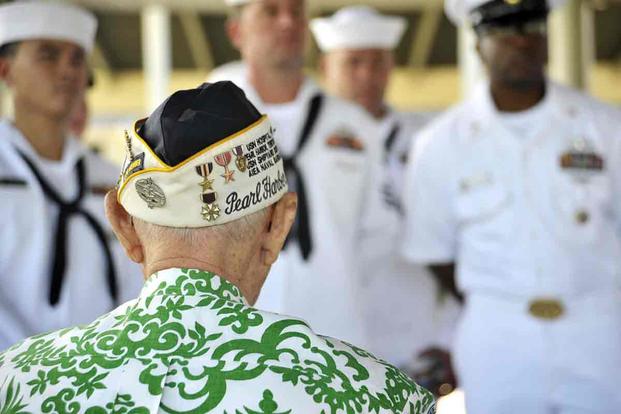The last known Pearl Harbor attack survivor living in Hawaii was laid to rest Thursday alongside his late wife at the Hawaii State Veterans Cemetery in Kaneohe.
Sterling Robert Cale was 102 years old when he died Jan. 10 in his Aiea home, which overlooked Pearl Harbor's battleship row. Even into the last years of his life, Cale regularly volunteered at the Pearl Harbor National Memorial to share his experiences with visitors. He would spend almost every birthday outside the bookstore there, often posing for photos with visitors and letting out his catch phrase "Ready, aim, fire !" as the camera clicked.
"It didn't matter how many times I've heard that, I smiled just as much as the people who heard it the first time—it was always fun, " recalled C.R. Drumhellier, commander of American Legion Post 17. "He was animated around the cake, giving fist bumps, and the kids loved it. Moms and dads obviously loved it, too."
During a eulogy, his grandson Sterling Robert Cale Jr. said he was "always humble, kind and patient. He never complained, even when he was in pain. I would always ask him how he was feeling today, and his answer to me was always the same : 'I feel with my hands. How do you feel ?'"
But though he was known for his sense of humor, he also carried with him painful memories of war.
Cale was raised in rural Illinois by adoptive parents, but many of the defining moments in his life happened in Hawaii—a duty station he had specifically chosen. He had seen pictures of the beaches and hula girls and knew that's where he wanted to go.
He joined the Navy and became a pharmacist's mate. On the day of the attack, he had just finished a long night of working at the base hospital. When Japanese planes flew into the harbor strafing and bombing American forces, Cale was among those who became part of the effort to rescue sailors who had gone overboard when their ships were attacked.
The ships leaked oil, which soon caught fire. The water's surface was burning, forcing Cale and other serv ice members to swim underwater beneath the flames as much as possible as they struggled to rescue trapped and drowning sailors.
Cale was in the water helping survivors when the USS Arizona exploded. Of the 2, 390 Americans killed in the attack, 1, 177 were members of the Arizona's crew.
After the initial explosion, the Arizona continued to burn for 2-1 /2 days. Cale became a member of a 10-
person detail that spent three weeks removing the bodies from the burning battleship, many of which were maimed and charred beyond recognition.
But despite being surrounded by death and war, Cale also found time in Hawaii for life. He fell in love with Victoria Ventula—a local girl who danced hula—and married in 1942 at historic Kawaiaha 'o Church.
During the war Cale went on to serve in the Pacific and fought in the Battle of Guadalcanal. He stayed in the Navy until 1948, then joined the Army, where he would serve decades in medical units. In Hawaii he served as head of the pharmacy at Tripler Army Medical Center and at a medical company at Schofield Barracks.
He served in the Korean War and after returning home was sent to language school where he learned French and Vietnamese. He did multiple tours in Vietnam as soldier and after leaving the military returned to Vietnam with the U.S. State Department working for the U.S. Agency for International Development.
After returning to Hawaii, he earned a degree from Chaminade University and got a job at the Officers Club at Schofield Barracks. In 2005 he retired after 57 years of government serv ice. For the rest of his life, he dedicated his time to his family and to volunteer work.
Among those who attended the funeral were Kit and Linda Lirot, a couple from Michigan who regularly summer in Hawaii. They had met Cale one of the days he was volunteering at Pearl Harbor and were taken by his charm and his openness.
"We thought he was an American hero. He had a very touching story and was very willing to share, " said Linda Lirot. "We saw on the news the other night that he had passed and decided we'd better rent a car and come up here. So here we are."
But while his military career brought him to Hawaii and defined much of his life, it was its people and culture that made him stay. He and his wife had two children, and their ohana would continue to grow. He is survived by four grandchildren and four great-grandchildren.
Neighbors and friends from across Oahu also turned out to say goodbye. He was well known in his neighborhood and community and loved going to Zippy's.
During his funeral service, his great-granddaughter Mikayla Lancaster-Hoover performed hula in his honor.
"My grandpa always appreciated Hawaiian culture. I'm Hawaiian, and he always encouraged me to do hula when I was little and so it's only right that I do it for him, " said Lancaster-Hoover. "He was just a treasure. ... He was just sort of a once-in-a-lifetime kind of guy. He always did everything for his family."
During remarks at the funeral, Jim McCoy, communications director of Pacific Historic Parks, told the Sterling family, "Thank you for sharing him with us. He meant so much to us."
Today of the 87, 000 military personnel who were stationed at Pearl Harbor on Dec. 7, 1941, only about two dozen remain alive.
"I recently walked by the bookstore. Outside there was nothing where he would usually stand, " said McCoy. "It was pretty quiet and kind of sad, but inside my head I heard, 'Ready, aim, fire !'"
___
(c)2024 The Honolulu Star-Advertiser
Visit The Honolulu Star-Advertiser at www.staradvertiser.com
Distributed by Tribune Content Agency, LLC.












